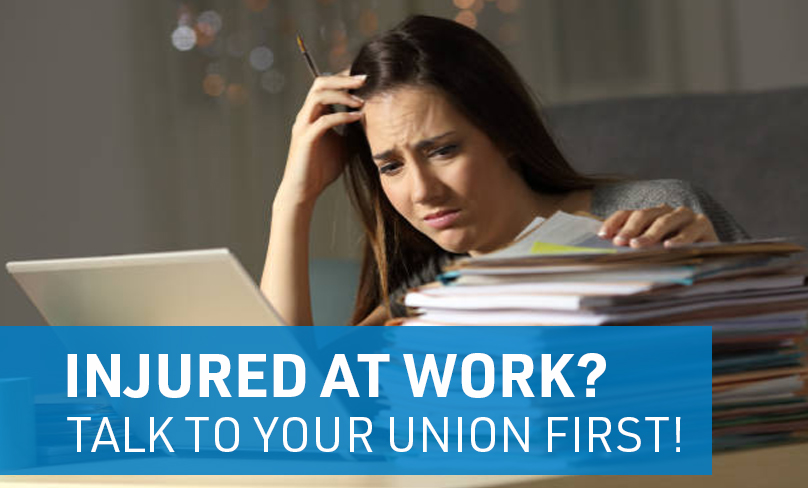INJURED AT WORK? TALK TO YOUR UNION FIRST!

Every employee has the right to a safe and healthy workplace under the Work Health and Safety Act 2012 (‘Act’). Every employer has a duty to provide a safe and healthy workplace and to consult with their employees about health and safety issues.
Though at first glance schools may not contain the same obvious risks and hazards as workplaces such as factories or construction sites, this does not mean that they are hazard free – in fact, the inconspicuous nature of many of the risks to health and safety found within a school environment can lead to them being ignored and becoming all the more dangerous and damaging over the long-term. Common risks in schools include excessive or unpredictable workloads, interaction with unpredictable or volatile students, bullying, inadequate breaks, and the potential rapid spread of illness.
All of these hazards present the very real risk of injury.
Injuries in the workplace can be broadly classified into three categories:
- Psychological injuries
caused by hazards such as work-related stress, bullying, excessive workload or the perceived risk of physical injury. - Physical injuries
caused by hazards such as manual handling or slips, repetitive strains, physical violence, trips and falls. - Diseases
caused by exposure to contagions or hazards such as asbestos and mould.
The Union Safety Effect
We hope you are never injured at work but we understand this may happen and what you do first in reporting your injury may make a considerable difference to the outcomes of your work injury claim.
The IEU has a long-standing involvement in the development of health and safety legislation and its implementation. One of the main reasons people join a union and remain a member is because of the great work unions do improving people’s health and safety at work. The support the IEU provides to schools contributes greatly to this work.
Too often, members contact the IEU after they have signed paperwork, had meetings with their employer or have taken some form of leave to deal with their injury. This may inhibit the options available for resolving your injury claim.
Duties of employees regarding injury
Employees must take reasonable care for their own health and safety, as well as the health and safety of other employees and students who may be affected by their actions or inactions.
Employees must also co-operate with their employer’s efforts to comply with their legal duties. This means that, while at work, employees must take reasonable precautions not to expose themselves or others to risk. They must also follow any reasonable OHS policies and adhere to the employer’s system for reporting OHS incidents and hazards.
Protection from discrimination
School employees are often reluctant to raise health and safety issues for fear of being treated negatively by their employer.
The Act provides protections from discrimination for those who raise issues. Employees who raise health and safety issues are legally protected against all forms of discrimination including demotion, unreasonable changes to position or hours of work, dismissal or contract termination, refusing or failing to engage an employee or treating a prospective employee less favourably than another (or threatening to do any of those things). In circumstances where discrimination is alleged to have occurred, the onus is on the employer to prove that they did not discriminate, and if found guilty they may be liable for damages and/or be ordered to reinstate the employee to their original position.
Work Injury? Take action now!
The injury is minor – why report it?
Members may dismiss their injury as unworthy of reporting but ALL injuries should be reported. This ensures that your employer is aware of the incident and it is correctly recorded. Early detection of symptoms for both physical and psychological injuries are important – be sure to make an accurate, dated written record.
Minor injuries may be soft tissue injuries from trips, slips or falls.
You may not require any treatment now but in the future if you suffer symptoms or complications from the workplace injury you have taken the necessary steps to ensure the employer is aware of how and when the injury occurred and logged it as occurring during the course of your employment.
Action to take at the time of the injury
- Your employer should have procedures in place for the reporting of workplace incidents and injury so complete those accordingly and keep a copy of all paperwork submitted. We recommend that you only speak with the IEU or a doctor regarding your injury once your paper work is lodged with your employer, until such time the claim is reviewed and a course of action has been recommended by the IEU.
- If you require medical attention ensure you ask your doctor for a Workers Compensation Medical Certificate. Keep copies of this certificate.
- If possible, contact the IEU (except in life-threatening or emergency hospital attendance situations) before attending your appointment and inform us of the nature of your injury and the date of your impending medical appointment. Do not delay your appointment in order to speak with us first – medical assistance should be sought appropriately.
How will the IEU assist?
- We will listen to you impartially. When we receive workplace injury advice we ‘triage’ your case to decide the appropriate action.
- To lodge a successful workplace injury claim we will need to establish:
- The injury sustained is compensable
- Your employment was undertaken in South Australia in a recognised non-government education facility
- Your work is the substantial cause of your injury.
- Documentation and notes from you are vital for establishing your claim, all correspondence should be in writing to your employer. Keep a copy of everything.
Early intervention is the key to getting your claim validated and managed.
Contact the IEU on 08 8410 0122 should you suffer a workplace injury.
If you aren’t a member of the IEU – join today
Additonal Sources:
https://www.legislation.sa.gov.au/LZ/C/R/WORK%20HEALTH%20AND%20SAFETY%20REGULATIONS%202012/CURRENT/2012.268.AUTH.PDF http://www.ieuvictas.org.au/files/5115/2781/8259/OHS-Handbook-FINAL-web.pdf

